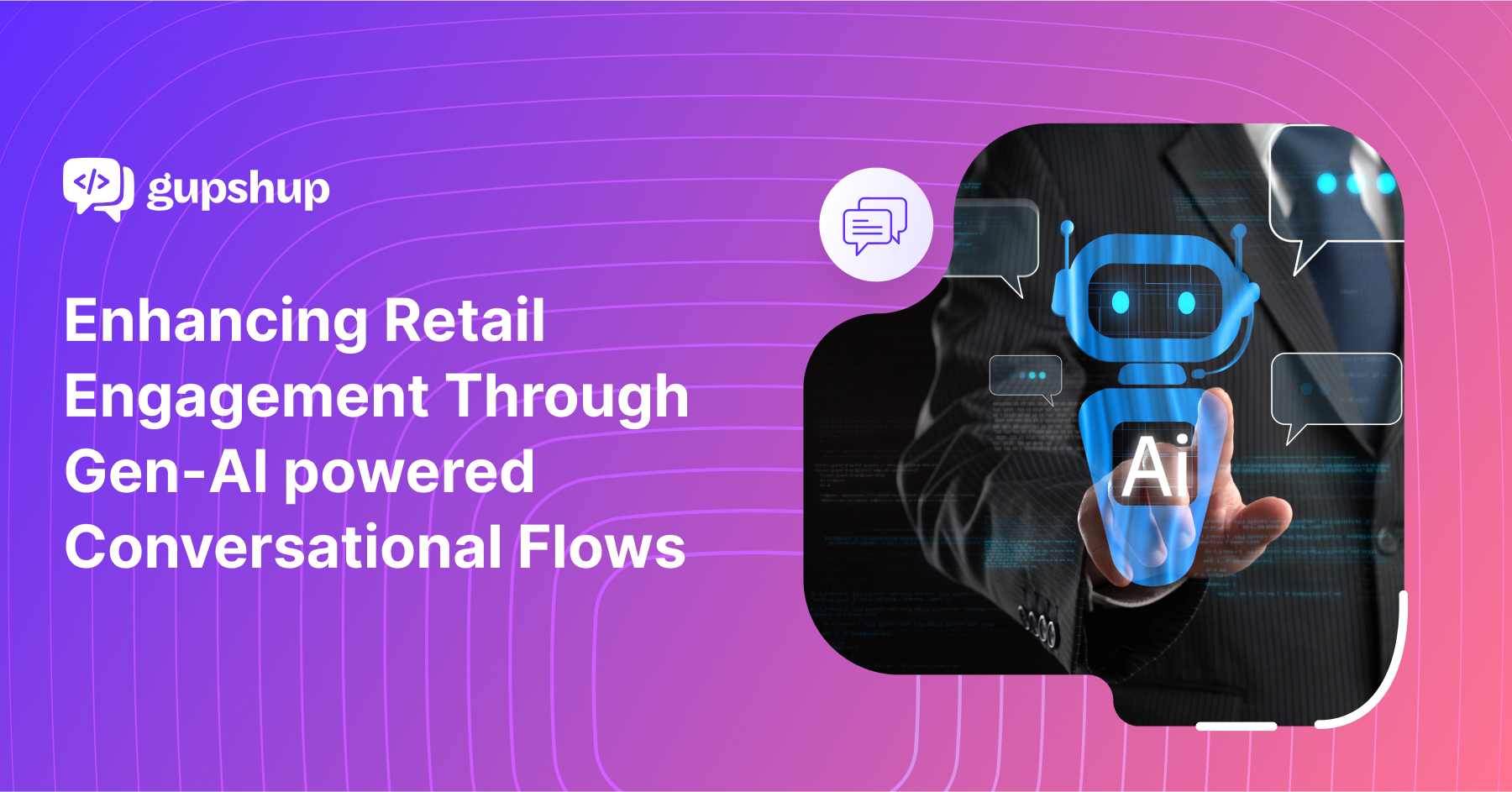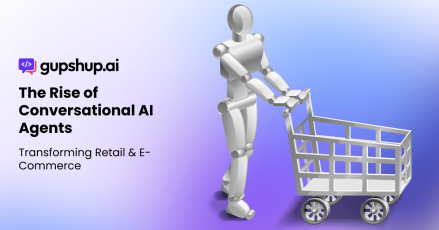How Retailers Can Combine Gen-AI with Conversational Flows to Deliver Personal Customer Interactions?

AI-driven technologies, especially Generative AI, are swiftly becoming a lifeline for retailers grappling with the shift in consumer preferences and economic pressures.
In the last two years alone, retailers have had to navigate a 40-year inflationary peak in mid-2022 and manage heightened consumer price sensitivity. This was a difficult time, with inflation impacting everything from consumer spending to operational costs.
In response, the retail industry needs to accelerate its technological transformation. This shift not only involved overhauling traditional tech architectures but also adopting more flexible, data-driven, and omnichannel approaches that align with the digital-first demands of modern consumers.
Hence, AI-driven technologies have come up as a key solution, enhancing customer experiences through personalization, streamlining operations, and building trust.
As such, AI not only addresses the immediate challenges but also positions retailers for long-term success in a rapidly evolving marketplace.
In this article, we have compiled a selection of AI-driven solutions that are transforming retail, packed with features designed to optimize customer interaction and operational efficiency.
Defining the Technologies and Their Roles
First, let’s understand Generative AI in retail.

Consider the technological journey from early communication platforms to today’s sophisticated systems. Look at how far we’ve come – transforming from static text exchanges to dynamic, AI-enhanced interactions.
This evolution majorly impacts how brands interact with consumers. The introduction of tools like Generative AI and Conversational Flows signifies a major leap forward. Let’s get into what these tools do.
Generative AI refers to artificial intelligence systems that can generate content, predict outcomes, and make decisions based on data inputs.
Moreover, Generative AI does not require any manual data input because it continuously analyzes customer data, learning from past interactions to predict and adapt to consumer behavior (and with impressive accuracy).
Now, let’s understand what Conversational Flow is.

Conversational Flows are simply automated interactions that follow a predefined sequence. This technology offers both responsiveness and consistency in customer service. WhatsApp Flows is a prime example of this technology in action.
These tools have completely transformed the retail industry. Let’s see how.
How do Retailers Integrate Generative AI and Conversational Flows

Now that we understand the differences between Generative AI and conversational flow, let’s dive into their impactful roles in retail.
These tools, when combined with each other, provide smart automation (i.e., understanding customer needs intimately and responding in real-time.) The result?
- Boosted customer satisfaction
- Increased sales
- Easy and seamless inventory management system (always keeping you ahead of consumer demands)
Here is how it all comes together –
- Customer Support: Think about a system that responds to customer queries almost instantly on platforms like WhatsApp. Generative AI makes this a reality by automating responses, slashing wait times, and ramping up satisfaction levels.
- Sales and Marketing: Now, let’s get to the interesting part. Instead of random product recommendations, Generative AI analyzes what your customers have liked or purchased before. It then uses WhatsApp Flows to send out perfectly timed, tailored messages that hit right when your customers are most likely to make a purchase. No prompts are needed—it just knows.
- Operational Efficiency: And it doesn’t stop there. Imagine knowing beforehand when you’re about to run out of your bestsellers. Generative AI forecasts these trends and lets customers know about upcoming stock issues through automated messages, keeping frustrations at bay.
Integration & Implementation Steps
Let’s look at a step-by-step integration and implementation –
- Data Integration and Analysis: First, feed your Generative AI system a rich diet of customer interaction data from your CRM or sales platforms. We’re talking about everything from past purchases to browsing habits.
- Setting Up Conversational Flows: Next up, use WhatsApp Flows to craft detailed communication paths that guide your customers from the first inquiry right through to checkout.
- Automating Interactions: Plug this data into WhatsApp Flows, and Generative AI tailors the conversation in real time based on what it knows about each customer.
- Engaging Customers: This setup works around the clock, autonomously engaging customers with insights-driven, personalized content and recommendations.
- Continuous Learning and Adaptation: With every interaction, Generative AI gets smarter, continually fine-tuning itself to improve future communications.
Leveling Up Customer Interactions with WhatsApp Flows
WhatsApp Flows turns chat into an interactive powerhouse:
Interactive Promotions: Customers can see promotions, look at the details, and act on them—all in one place, without leaving the chat.

Efficient Feedback Mechanisms: Got feedback? WhatsApp Flows makes it easy for customers to fill out forms, get quick replies, and track their queries in real-time with Calls To Action like “Contact Us”.

Simplified Booking Systems: A few taps in the chat, and the booking is made—no phone calls, no waiting, just “Book Now”.

Streamlined Inquiries and Subscriptions: Need a quote? Customers can get personalized pricing on the fly, and signing up for services is just as easy.

Let’s look at an example of conversational flow in action. RedBus, a bus ticketing platform, used WhatsApp Flows to enhance customer interactions during the booking process. Through WhatsApp, RedBus customers can book tickets, make payments, and receive post-trip services like ratings and reviews collection. This integration makes booking easier and boosts customer engagement, with an 80% higher response rate on WhatsApp than other notification methods.
Benefits of Generative AI and Conversational Flows

If your retail business seamlessly adapts to each customer’s unique needs and preferences, providing a shopping experience that feels tailor-made just for them. That’s the power of Generative AI and Conversational Flows in retail. It provides the following benefits –
Enhanced Customer Experiences
Generative AI and Conversational Flows redefine the retail landscape by offering unparalleled customer experiences, driving engagement, and fostering brand loyalty. By using AI-powered chatbots and conversational flows, businesses can provide personalized assistance and recommendations, making each customer feel valued and understood.
Wow! Momo, a prominent quick-service restaurant chain in India, used Gupshup’s AI conversational platform to enable direct food ordering via WhatsApp. This integration allowed customers to place orders, browse menus, and receive customer support directly through WhatsApp.
This move helped increase the share of direct orders and bolstered customer retention through a more engaging and simplified ordering process.
Practical Applications
Generative AI and Conversational Flows offer a myriad of practical applications in retail, spanning from promotions to customer service feedback and appointment booking.
Take, for example, the case of Axis Bank. Axis Bank’s ‘Aha!’, an AI-powered bot, efficiently manages over 20 million queries with 97% accuracy, showcasing how AI improves customer service in the banking sector.
Integration with Chatbots
Integrating Generative AI and Conversational Flows with chatbots can help businesses supercharge their customer support capabilities, ensuring prompt and efficient assistance around the clock.
One such example is Swiggy, India’s leading food delivery platform, which uses WhatsApp Flows to enhance customer engagement. Customers can interact with the chatbot to place orders, track deliveries, and resolve issues – all through conversational interactions powered by AI.
This integration not only improves the overall customer experience but also reduces the workload on customer support agents, enabling them to focus on more complex inquiries.
Personalized Interactions
Generative AI enables businesses to deliver personalized interactions at scale, driving customer engagement and satisfaction.
For instance, OYO, a global hospitality service provider, adopted Gupshup’s platform to enhance customer engagement across various channels. By using conversational AI, OYO was able to provide personalized booking assistance, customer support, and promotional messaging through WhatsApp, improving service delivery and customer interaction at a global scale.
Efficient Operations
By automating routine tasks through Generative AI and Conversational Flows, businesses can streamline their operations, reduce costs, and improve efficiency.
For example, NoBroker, a real estate platform, uses conversational AI to enhance its users’ property listing experience. By integrating conversational AI, NoBroker allowed potential tenants and buyers to interact and transact via WhatsApp, streamlining the communication process. This approach not only improved customer satisfaction but also drove higher engagement rates. It also increased returns on investment by reducing dependency on traditional customer interaction methods.
Real-Time Assistance
Generative AI enables businesses to provide real-time assistance to customers, addressing inquiries and issues promptly.
Gupshup, for a global herbal wellness brand, developed a Digital Assistant to enhance the customer experience across channels. These channels include the brand’s website, Facebook, WhatsApp, and others.
This AI-powered assistant automated 70% of customer queries within two months of its launch. It directly contributed to increased sales conversions and reduced the workload for customer service teams. It helped by automating over 700 hours of conversations per month.
The system also provided real-time assistance, enabling customers to receive immediate support and guidance. By increasing engagement and allowing a seamless transition between automated service and human interaction, it offered the needed support.
What The Future Holds
The integration of Generative AI with Conversational Flows in retail is poised to not only enhance the customer experience but also revolutionize the efficiency and responsiveness of retailers.
The potential for these technologies to drive significant improvements in customer interaction and operational efficiency is immense. By 2025, nearly 95% of customer interactions in retail will be powered by AI technologies, including AI conversational platforms.
This will increase customer satisfaction rates by 25% and revenue by 15% through personalized and efficient service offerings.
The future of retail lies in the ability of retailers to adapt and innovate. As these technologies evolve and become more integrated into the retail landscape, businesses will have more refined interactions.
The adoption and refinement of these AI-driven interactions will be well-positioned to lead to customer satisfaction. Operational excellence is the next thing affected positively and securing a competitive edge in the rapidly changing retail market.
For those ready to embark on this transformative path, the future is not just bright but dynamic and responsive. It can be tailored to the needs and desires of each customer.
Learn more about what the future holds for your business with Gupshup. Get in touch!




